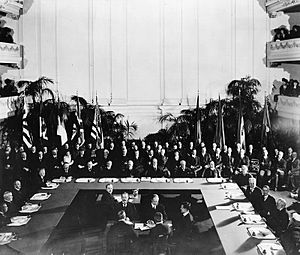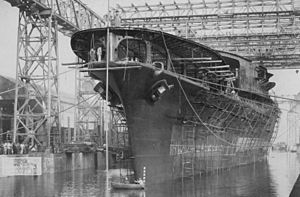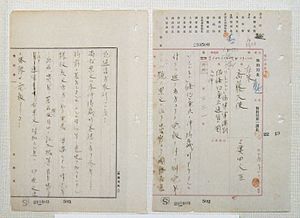Washington Naval Treaty facts for kids
| Limitation of Naval Armament | |
|---|---|

Signing of the Washington Naval Treaty (1922).
|
|
| Type | Arms control |
| Context | World War I |
| Signed | February 6, 1922 |
| Location | Memorial Continental Hall, Washington, D.C. |
| Effective | August 17, 1923 |
| Expiration | December 31, 1936 |
| Negotiators |
|
| Signatories | |
| Parties | |
| Depositary | League of Nations |
| Citations | 25 L.N.T.S. 202 |
| Languages | |
The Washington Naval Treaty, also known as the Five-Power Treaty, was an important agreement signed in 1922. It involved the main countries that won World War I: the United Kingdom, the United States, France, Italy, and Japan. The goal of the treaty was to stop a costly arms race (when countries build more and more weapons to try and be stronger than others).
The treaty limited how many large warships, like battleships and aircraft carriers, each country could build. It was agreed upon at the Washington Naval Conference in Washington, D.C.. This meeting took place from November 1921 to February 1922. The treaty was officially signed on February 6, 1922, and became active on August 17, 1923.
Later, other agreements tried to add more limits on warship building. The rules of the Washington Naval Treaty were changed by the London Naval Treaty in 1930 and the Second London Naval Treaty in 1936. However, by the mid-1930s, Japan and Italy decided to leave these agreements. Nazi Germany also ignored the Treaty of Versailles, which had limited its navy. This made it harder for other countries to control naval weapons.
Contents
Why the Treaty Was Needed
After World War I, Britain had the biggest navy in the world. The United States was second, and Japan, France, and Italy followed. Many countries were worried about a new arms race starting. This was because the US, Britain, and Japan all had plans to build many new, powerful warships.
For example, the US planned to build 50 modern battleships. Japan wanted to build an "eight-eight" fleet, meaning eight battleships and eight battlecruisers. Britain also planned to build new battleships. Building these huge ships was very expensive.
People in the United States did not want to spend so much money on more ships. Britain also could not afford to keep building battleships after the war. Because of these money worries, US President Warren Harding called the Washington Naval Conference in November 1921. The goal was to discuss how to limit naval weapons and keep peace in the Pacific Ocean and Far East.
How the Treaty Was Agreed Upon
At the start of the conference, Charles Evans Hughes, who was the US Secretary of State, made a bold statement. He said, "The way to disarm is to disarm." This idea was very popular with the public. It helped the conference move quickly and led to many of his ideas being accepted.
Hughes suggested a few key things:
- Stop building large warships (battleships and battlecruisers) for ten years.
- Scrap some existing or planned large warships. This would create a specific ratio of ship sizes for the five main countries.
- Keep limits on the total size of large warships and other types of ships.
Limiting Large Warships
The British agreed with most of the ideas for limiting large warships. However, some people in the British Royal Navy were upset. They felt Britain would not have enough ships to protect its interests around the world. But Britain needed to save money after the war. Also, a war with the US seemed unlikely, so limiting ships made sense.
The Japanese delegation was divided. Some believed Japan needed a navy 70% the size of the US Navy to win any future war. However, the head of their delegation, Katō Tomosaburō, knew that Japan could not win an arms race against the US. The US had much more industry and could build many more ships. So, he pushed for Japan to accept the limits.

The French initially did not want to reduce their large warships so much. They asked for more ships. But after some talks about other types of ships, they agreed to the limits. Italy also wanted to have the same number of ships as France, which was a big success for them, even if they never actually reached that goal.
One important point was about the Japanese battleship Mutsu. The Japanese people had helped pay for this ship with donations. So, Japan really wanted to keep it. To allow Japan to keep the Mutsu, the US and Britain were allowed to build a couple of similar ships.
Limiting Smaller Warships
Hughes also wanted to limit smaller ships like cruisers and destroyers in the same way as large ships. But Britain and France disagreed. Britain wanted more cruisers because of its large British Empire.
Instead, they agreed to limit the size of future cruisers. They decided that cruisers could be no bigger than 10,000 tons and could have guns no larger than 8 inches. This rule allowed Britain to keep its new Hawkins class ships. It also fit with US and Japanese plans for their own cruisers.
Submarines and Bases
Britain wanted to ban submarines completely because they had been very effective against them in World War I. But France strongly opposed this idea. So, the conference ended without any limits on submarines.
The treaty also had a rule about naval bases in the Pacific Ocean. Britain, Japan, and the US agreed not to build any new forts or naval bases there. Existing bases in places like Singapore, the Philippines, and Hawaii could stay. This was a big win for Japan. It meant Japan would be the strongest naval power in the Western Pacific Ocean. This rule helped Japan agree to the limits on large warships.
Treaty Rules and Limits
The treaty set strict limits on the total weight (tonnage) of large warships and aircraft carriers each country could have. It also limited the size of individual ships.
| Tonnage limitations | ||
| Country | Capital ships | Aircraft carriers |
|---|---|---|
| British Empire | 525,000 tons (533,000 tonnes) |
135,000 tons (137,000 tonnes) |
| United States | 525,000 tons (533,000 tonnes) |
135,000 tons (137,000 tonnes) |
| Empire of Japan | 315,000 tons (320,000 tonnes) |
81,000 tons (82,000 tonnes) |
| France | 175,000 tons (178,000 tonnes) |
60,000 tons (61,000 tonnes) |
| Italy | 175,000 tons (178,000 tonnes) |
60,000 tons (61,000 tonnes) |
The limits meant that Britain and the United States had the most ships. Japan had about 60% of their strength, and France and Italy had about 33%.
Here are some specific limits:
- Large Warships (battleships and battlecruisers) could not be heavier than 35,000 tons. Their guns could be no larger than 16 inches.
- Aircraft Carriers were limited to 27,000 tons. They could have no more than 10 heavy guns, with a maximum size of 8 inches. However, each country could convert two existing large warship hulls into carriers, up to 33,000 tons each. Carriers lighter than 10,000 tons did not count towards the limits.
- Other Warships (like cruisers and destroyers) were limited to 10,000 tons and 8-inch guns.
The treaty also listed which ships each navy could keep. It explained how to make ships unusable for military purposes, like sinking them or removing their weapons. In total, the United States had to scrap 30 ships, Britain 23, and Japan 17.
What Happened After the Treaty
The Washington Naval Treaty stopped the building of huge battleships for more than a decade. Many ships that were being built were either scrapped or turned into aircraft carriers. The rules were followed and even expanded by the London Naval Treaty of 1930. It wasn't until the mid-1930s that countries started building battleships again.
The treaty had less effect on cruiser building. Because it set a maximum size of 10,000 tons and 8-inch guns for cruisers, many navies started building ships exactly that size. These were called "treaty cruisers." This led to a new kind of building competition.
An unofficial effect of the treaty was the end of the Anglo-Japanese Alliance. The American delegates made it clear they would not agree to the treaty if Britain kept its alliance with Japan.
Breaking the Rules
Some countries eventually broke the treaty rules.
- In 1935, the French Navy started building battleships that put them over their allowed total weight. France argued that Britain had also broken rules by signing a separate naval agreement with Germany.
- Italy also broke the rules. They built cruisers that were heavier than the 10,000-ton limit. Later, they built battleships that were much heavier than the 35,000-ton limit, even though they claimed the ships were within the rules.
Japan Leaves the Treaty
The naval treaty had a big impact on Japan. Japan knew it could not win a long war against the US or Britain because those countries had much more industry. Many Japanese people felt the 5:5:3 ship ratio was unfair.
This treaty caused arguments within the Imperial Japanese Navy. Some officers, called the "Treaty Faction," supported the treaty. Others, the "Fleet Faction," were against it and wanted a stronger navy. They were also linked to extreme nationalist groups in Japan.
Some people believe the treaty pushed Japan towards expanding its power in the early 1930s. The feeling that the treaty was unfair led Japan to leave the Second London Naval Treaty in 1936.
Isoroku Yamamoto, who later planned the attack on Pearl Harbor, believed Japan should stay in the treaty. He knew that the US could build far more ships than Japan. He once said, "Anyone who has seen the auto factories in Detroit and the oil-fields in Texas knows that Japan lacks the power for a naval race with America." He thought the treaty actually helped Japan by limiting other countries. He believed Japan needed other ways to balance power, which might have led to his idea for the Pearl Harbor attack.
On December 29, 1934, Japan officially announced it would end the treaty. Its rules stayed in place until the end of 1936 but were not renewed.
Secret Information
What the countries at the conference did not know was that the American "Black Chamber" (a US intelligence group) was secretly listening to their communications. They especially learned a lot from Japanese messages. This allowed American negotiators to know the lowest limits Japan would accept.
Because the treaty was unpopular with many in the Japanese Navy and with nationalist groups, the fact that the Japanese government accepted these limits caused a lot of suspicion and anger among Japanese politicians and naval officers.
See also
- Arms control



